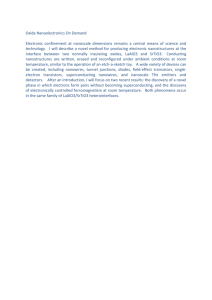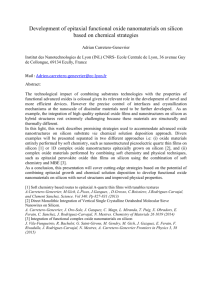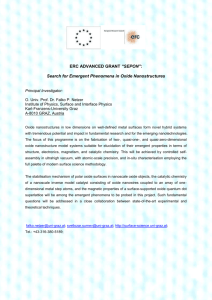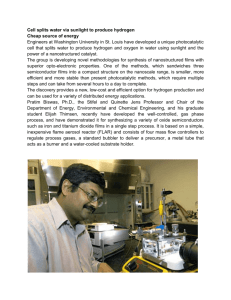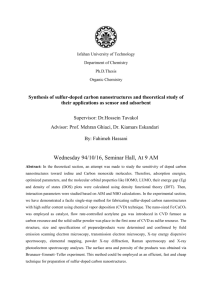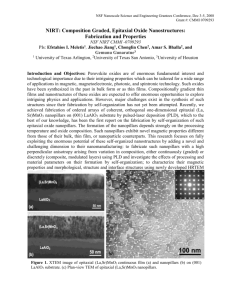Spin polarized transport in semiconductors – Challenges for
advertisement
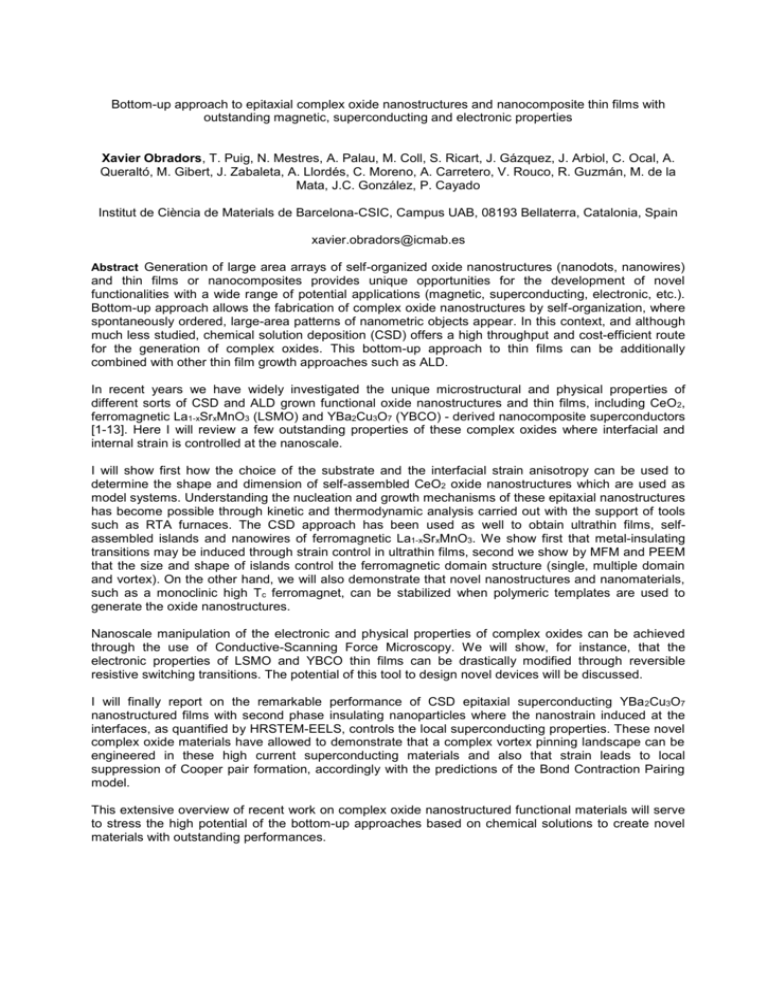
Bottom-up approach to epitaxial complex oxide nanostructures and nanocomposite thin films with outstanding magnetic, superconducting and electronic properties Xavier Obradors, T. Puig, N. Mestres, A. Palau, M. Coll, S. Ricart, J. Gázquez, J. Arbiol, C. Ocal, A. Queraltó, M. Gibert, J. Zabaleta, A. Llordés, C. Moreno, A. Carretero, V. Rouco, R. Guzmán, M. de la Mata, J.C. González, P. Cayado Institut de Ciència de Materials de Barcelona-CSIC, Campus UAB, 08193 Bellaterra, Catalonia, Spain xavier.obradors@icmab.es Abstract Generation of large area arrays of self-organized oxide nanostructures (nanodots, nanowires) and thin films or nanocomposites provides unique opportunities for the development of novel functionalities with a wide range of potential applications (magnetic, superconducting, electronic, etc.). Bottom-up approach allows the fabrication of complex oxide nanostructures by self-organization, where spontaneously ordered, large-area patterns of nanometric objects appear. In this context, and although much less studied, chemical solution deposition (CSD) offers a high throughput and cost-efficient route for the generation of complex oxides. This bottom-up approach to thin films can be additionally combined with other thin film growth approaches such as ALD. In recent years we have widely investigated the unique microstructural and physical properties of different sorts of CSD and ALD grown functional oxide nanostructures and thin films, including CeO 2, ferromagnetic La1-xSrxMnO3 (LSMO) and YBa2Cu3O7 (YBCO) - derived nanocomposite superconductors [1-13]. Here I will review a few outstanding properties of these complex oxides where interfacial and internal strain is controlled at the nanoscale. I will show first how the choice of the substrate and the interfacial strain anisotropy can be used to determine the shape and dimension of self-assembled CeO2 oxide nanostructures which are used as model systems. Understanding the nucleation and growth mechanisms of these epitaxial nanostructures has become possible through kinetic and thermodynamic analysis carried out with the support of tools such as RTA furnaces. The CSD approach has been used as well to obtain ultrathin films, selfassembled islands and nanowires of ferromagnetic La1-xSrxMnO3. We show first that metal-insulating transitions may be induced through strain control in ultrathin films, second we show by MFM and PEEM that the size and shape of islands control the ferromagnetic domain structure (single, multiple domain and vortex). On the other hand, we will also demonstrate that novel nanostructures and nanomaterials, such as a monoclinic high Tc ferromagnet, can be stabilized when polymeric templates are used to generate the oxide nanostructures. Nanoscale manipulation of the electronic and physical properties of complex oxides can be achieved through the use of Conductive-Scanning Force Microscopy. We will show, for instance, that the electronic properties of LSMO and YBCO thin films can be drastically modified through reversible resistive switching transitions. The potential of this tool to design novel devices will be discussed. I will finally report on the remarkable performance of CSD epitaxial superconducting YBa 2Cu3O7 nanostructured films with second phase insulating nanoparticles where the nanostrain induced at the interfaces, as quantified by HRSTEM-EELS, controls the local superconducting properties. These novel complex oxide materials have allowed to demonstrate that a complex vortex pinning landscape can be engineered in these high current superconducting materials and also that strain leads to local suppression of Cooper pair formation, accordingly with the predictions of the Bond Contraction Pairing model. This extensive overview of recent work on complex oxide nanostructured functional materials will serve to stress the high potential of the bottom-up approaches based on chemical solutions to create novel materials with outstanding performances. References [1] M. Gibert et al.; Adv. Mater. 19 (2007) 3937 [2] C. Moreno et al.; Adv. Funct. Mater. 19 (2009) 2139 [3] M. Gibert et al.; Small 23 (2010) 2716 [4] A. Carretero-Genevrier et al.; J. Am. Chem Soc. 133 (2011) 4053 [5] P. Abellán et al.; Appl. Phys. Lett. 98 (2011) 041903 [6] J. Zabaleta et al. ; J. Appl. Phys. 111 (2012) 024307 [7] C. Moreno et al. ; Nano Lett. 10 (2010) 3828 [8] J. Gutierrez et al. ; Nature Mater 6 (2007) 367 [9] A. Llordés et al. ; Nature Mater 11 (2012) 329 [10] A. Carretero-Genevrier et al.; Chem. Comm. 48 (2012) 6223 [11] M. Coll et al. ; Chem. of Mater. 24 (2012) 3732 [12] J. Zabaleta et al. : Nanoscale (2013) [13] R. Guzmán et al. ; Appl. Phys. Lett. (2013)


